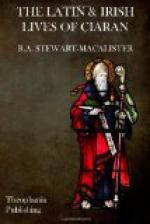The Geographical Names in LA.—Loch Rii (properly Loch Rib) is Loch Ree on the Shannon, above Athlone. The island called Inis Aingin has now the name of Hare Island; it is at the south end of the lake near the outlet of the river. There are some scanty remains of a monastic establishment to be seen upon it.
XXXVIII. CIARAN IN INIS AINGIN (LA, LB, VG)
The Presbyter Daniel.—For the presence here of a Welsh or British priest, see the remarks in Plummer, VSH, i, p. cxxiv. But it is probable that in the original form of the story the presbyter Daniel was a fictitious ecclesiastic, perhaps the Evil One disguised. We may compare the two false bishops that came to expel Colum Cille from Iona (LL, 1007). Biblical names were sometimes used in the early Irish Church, though native names were preferred. There is actually the monument of a person called Daniel at Clonmacnois; it is a slab, bearing an engraved cross and inscription, probably of the ninth or tenth century.
The Gift.—This is said in VG to have been a cup adorned with birds. Such forms of decoration seem to have been common, and are sometimes referred to in Irish romances, though few, if any, examples that may be compared with the descriptions have come down to us. In LA a word antilum is used, which does not appear to occur anywhere else, and is unknown to our lexicographers. It is possibly a corruption for an(n)ulum, “a ring.” Naturally this tale of the gift must be a later accretion to the story, if it had the origin just suggested.
Note, in the long eulogy of the saint which the author of LB gives us here, that the writer has not hesitated to introduce reminiscences of Phil, ii, 7, 8, thus hinting at the general Tendenz of the Lives of Saint Ciaran. The rest of the eulogy is a free paraphrase of Rom. xii, 9 ff. There is extant a metrical “Monastic Rule” attributed to Saint Ciaran, which was edited by the late Prof. Strachan in Eriu (The journal of the Dublin “School of Irish Learning”) vol. ii, p. 227. The subject-matter of this composition is a series of regulations on morality and mortification of the flesh, but the language is so obscure, and the text of the single MS. which alone contains it is so corrupt, that even the pre-eminent Celtist who edited the poem would not venture on a translation.
XXXIX. THE COMING OF OENNA (LA, LB, VG)
Parallels.—As Ciaran recognised Oenna by his voice, so Colman picked out by his voice one of a number of soldiers destined for a religious life (VSH, i, 261). With the incident of the consecration, as successor, of an unprepossessing intruder, compare the tale of Findian consecrating for the same purpose a raider whom he caught hiding in the furnace-chamber of his kiln (LL, 2628 ff.; CS, 198). The version in LB conveys the impression that Oenna’s learning was imparted to him miraculously, as Oengus the Culdee inspired an idle boy with a miraculous knowledge of his neglected lesson.[22]




